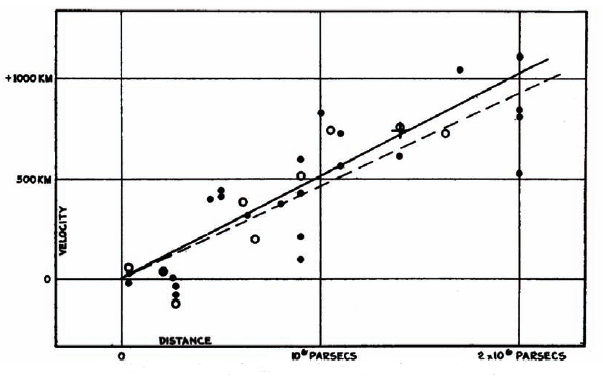More on Hubble's Law

(Image courtesy AIP Emilio Segre Visual Archives)
Looking at the skies from Mt. Palomar in the 1920s, Edwin Hubble found that nearly all far away spiral nebulae (now known as galaxies) in the Universe are moving away from us. This motion, called their recession velocity, is greater the further they are from us. In fact, he found the relationship between a galaxy's velocity away from us (v) and its distance from us (d) approaches a fairly linear one, which is known as Hubble's Law:

where H0 is an observationally determined constant called Hubble's constant. Finding the value of Hubble's constant is still a current topic in astronomy, and it has implications for our understanding of how the Universe evolved since the Big Bang.
Hubble's finding built on the work of Vesto M. Slipher who, in 1912, discovered that light from nearly all of the "spiral nebulae" he observed, regardless of the direction he looked, appeared to be redshifted. This meant they were moving away.
In 1924 Hubble discovered that the "spiral nebulae" were actually galaxies outside our Milky Way galaxy. Hubble was able, along with his research assistant Milton Humason, to measure distances to a number of the spiral nebulae.
Edwin Hubble sought to find a relationship between their distance from us and their speed. He plotted recessional velocity determined by the doppler shift of stellar spectra as a function distance and established what is now know as Hubble's Law. Hubble's law applies to the objects in the Universe on the largest scales, where the force driving their motions is the expansion of the Universe.

(Hubble, Proceedings of the National Academy of Sciences, 1929, 15, 168)
 Learn more about what Hubble's Law means
Learn more about what Hubble's Law means
 Quiz your knowledge of what Hubble found
Quiz your knowledge of what Hubble found



